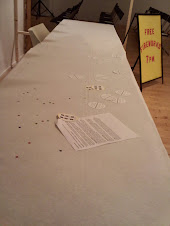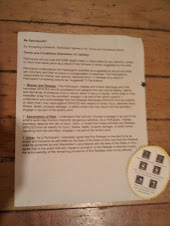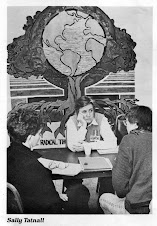I love yoga. I love the way I feel when I'm practicing it. I love going to the studio where I practice four or fives times a week, where I know at least a third of the people in the room at any given time/class. I love the teachers at my studio. I love that way the practice makes my body feel and look. I love teaching it and helping people along as they experience the practice for themselves, in their own beautiful, unique bodies. I've been practicing regularly for two years (and sporadically for even longer) and it's changed my life. It helps me keeps me calm and makes me happier, giving me a patience that I never thought I'd have.
I also love feminism and am an unabashed feminist and gender studies scholar. As I prepare to wrap up a six month yoga teacher training (YTT) program this weekend, I've been thinking a great deal about how these passions converge and diverge. Case in point: a few months ago the teacher/leader of my YTT program lectured on the mythical story to Rama, Seta, and Hanuman. Rama, the masculine figure, represents side of social or cultural side of humanity, and Seta, the feminine figure, represents the natural side of humanity. In the tale, Seta is banished from culture for an alleged sexual indiscretion, and Hanuman (the monkey), travels on Rama's behalf to reunite her with Rama. Hanuman is therefore the bridge between the natural and the cultural. After our teacher's lecture, one of my YTT colleagues commented that she was troubled that Seta--the feminine character--was banished. Another of my peers echoed these sentiments, saying something like, "Yeah, that didn't make the feminists in the room very happy" (I always love it when I [often the sole feminist/gender studies person in the room] am not the one who speaks up first). Our teacher (who is bright and fun and generally amazing) told us that we were reading too much into the story. But were we? Yoga and all of it's intricately complex traditions, as ancient as they are, was created by humans and reflects the social mores, ideals, and ideologies of the time(s). This said, it is wrought from patriarchal ideologies and power structures that are historically and contemporarily pervasive in culture.
Yoga is about "yoking," or uniting breath/prana and movement/asana, as well as uniting people and finding commonalities across gender, race, class, sexual identity, and a myriad of other individual experiences and realities. I have experienced this in ways that I never could have imagined, finding love and compassion for people I would never have imagined connecting with had it not been for yoga. These connections are very powerful and dear to me.
Yet, as a feminist, I am cognizant of the fact that many of the most famous contemporary yogis are men. Think Rodney Yee, Max Strom, and Rolf Gates, Baron Baptiste, and Bikram Choudhury, not to mention the godfathers of contemporary yoga like BKS Iyengar, Sri K. Pattabhi Jois, Sri T. Krishnamacharya, and Sri Swami Satchidananda, and rising yoga stars like Jonny Kest. There are famous women yogis, of course, including Lilias Folan, Shiva Rea, and Seane Corn, yet, given recent statistics on the gender of U.S. yoga practitioners--in 2008 72.2% of practicing yogis were female, 27.8% were male--the proportion of famous female yogis does not reflect the breakdown of yoga students/practitioners who regularly step on to their mats.* Moreover, while some cursory Internet research on the breakdown by gender of "ordinary" yoga teachers didn't provide solid statistics, it's clear (based on viewing numerous studio sites across the U.S.) that a majority of them are women.
This said, what should I--a Ph.D.-ed feminist historian/scholar and soon to be teacher of yoga--do about the imbalances inherent in the practical aspects of the practice? While conducting research for this post, I was happy to find that I am not the only woman yoga practitioner-lover to address its gendered dimensions (see for instance, yogasuzi's post from 2007-08 http://yogalikesalt.wordpress.com/2007/08/13/yoga-and-gender/).
Thoughts anyone?
*NAMASTA (North American Studio Alliance) provides 2008 statistics on yoga participation in the U.S., citing the Yoga in America Study (see http://www.namasta.com/pressresources.php#2).
Monday, March 15, 2010
Subscribe to:
Post Comments (Atom)




































This comment has been removed by the author.
ReplyDeleteHI Lyz! Olga here (once also from Cleveland). This is a great post - and congratulations on your Yoga Teacher Training!
ReplyDeleteWhat you write brings to mind a quote from Anais Nin: "We see the world not as it is but as we are." And so, much of the Western yoga world reflects our western values: patriarchy, commercialism, famous "experts" as authorities... and "don't read into it too deeply"...
This year, I am proud to celebrate 10 years since my Yoga Teacher Training at Cleveland's ATMA Center, which teaches in the Satyanada Tradition. Swami Satyananda, a disciple of Swami Sivananda founded a yoga University in India's poorest state: Bihar. He realized that for humanity to evolve, we must raise the status of women. In a pioneer fashion, he started schools for local girls, teaching them reading, writing, English, computers, and yoga until the age of 13. Thanks to this, over the past several decades, thousands of girls gained opportunities never before possible.
The symbolic culmination of this effort takes place at an annual event/celebration called Sita Kalayanam. (see www.yogavision.net for details.) This is a symbolic, 5-day reenactment of the story that prompted your post: the marriage of Sita and Rama. At this event, it is the prepubescent girls who are the hosts. Sw. Satyananda says that they are the true images of the Goddess, still in touch with the wild nature within them, and thus are celebrated as Goddesses, adorned and served by the adult "leaders" of the community as an act of Goddess-worship. He talks about this ancient story as a hyperbole for modern times, in which the true female powers and connection to nature has indeed been awfully banished and so, it is each of our responsibilities to become Hanuman to reunite these forces so that our world can once again be complete and humanity can evolve. In this sense, I see the story as deeply feminist.
When we dig deeper into yoga and its history (unavoidably parallel to the history of humanity), we may find that it can be a source of strong feminist inspiration and action. It is up to us who have that consciousness to make the connections and to bring them to our students, healing the world one soul at a time.
Om Tat Sat,
O.